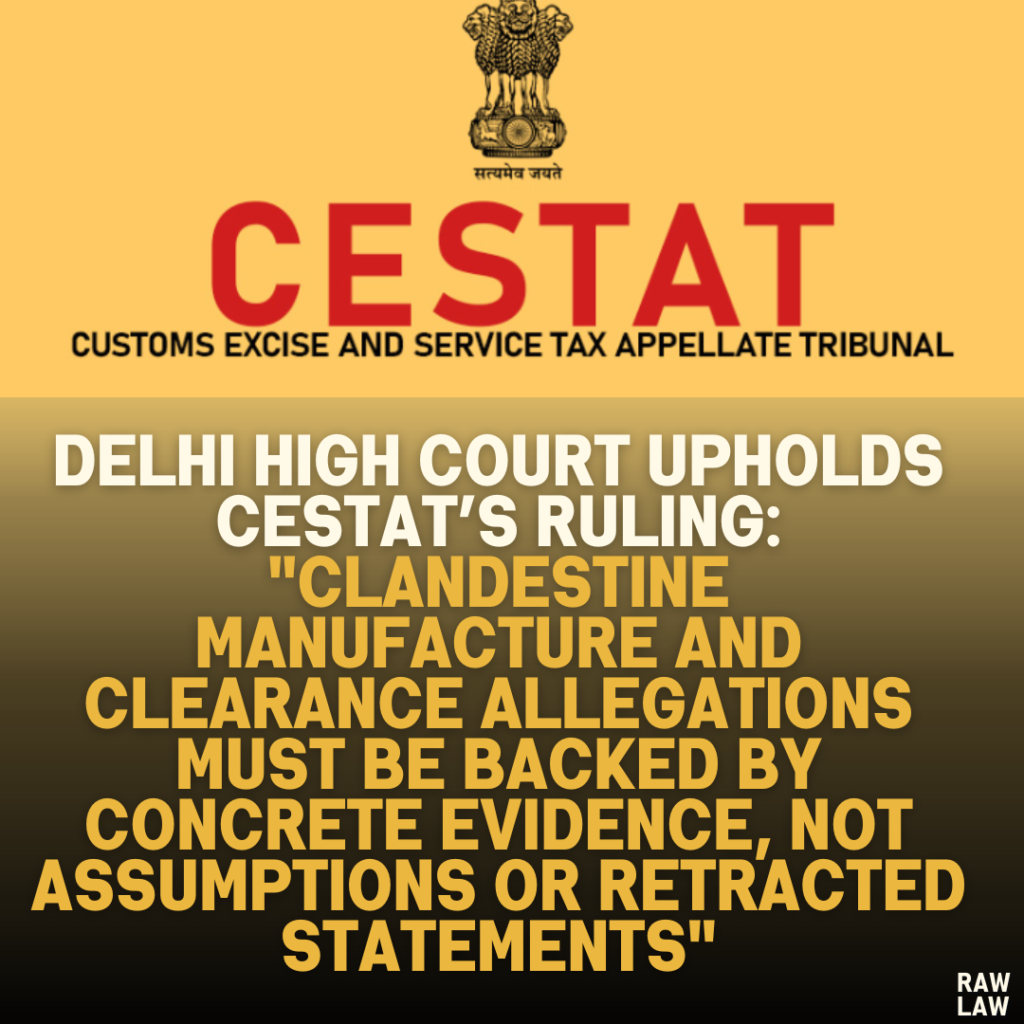Court’s Decision
The Delhi High Court dismissed the Revenue’s appeal against the CESTAT’s decision, finding no substantive evidence to prove allegations of clandestine manufacture and clearance of goods. The Court held that the CESTAT correctly examined and appreciated the evidence, which fell short of the legal standards required to sustain the charges.
Facts
- The respondent was engaged in manufacturing copper ingots and was registered under the Central Excise Department.
- In 2005, DGCEI searched the respondent’s factory and related premises. The officers claimed to have discovered:
- A shortage of 3500 kg of copper scrap, valued at ₹3,85,000.
- Indian currency amounting to ₹6,20,000, suspected to be sale proceeds from clandestine clearance.
- Records and notebooks allegedly evidencing unaccounted production and sales.
- Two SCNs were issued alleging:
- Procurement of raw materials without invoices.
- Unaccounted manufacture and clearance of goods without duty payment.
- Total duty evasion of over ₹4 crore was alleged.
- The adjudicating authority confirmed the demand, but the CESTAT set aside the order, holding that the evidence was inadequate.
Issues
- Did the Revenue provide sufficient evidence to establish clandestine manufacture and clearance?
- Were the findings of the CESTAT erroneous or contrary to the facts?
Petitioner’s Arguments (Revenue)
- Evidence Reliance: The Revenue argued that documents recovered from the respondent’s premises and statements from employees corroborated their case.
- Burden of Proof: It contended that the burden to disprove the allegations rested on the respondent.
- Procedural Soundness: The Revenue maintained that its investigative methodology and findings were sound, despite claims to the contrary by the respondent.
Respondent’s Arguments
- Flawed Evidence: The respondent asserted that the recovered documents did not pertain to it, and the Revenue failed to provide direct evidence linking the allegations to the respondent’s operations.
- Retracted Statements: Witness statements relied upon by the Revenue were retracted, making them unreliable without corroborative evidence.
- Procedural Deficiencies: The respondent emphasized lapses in the investigation, including denial of cross-examination rights.
Analysis of the Law
- Standard of Proof: The Court noted that adjudication proceedings require proof based on the “preponderance of probabilities,” unlike criminal cases, which require proof “beyond reasonable doubt.”
- Clandestine Removal: The Court stressed that allegations of clandestine removal are serious and must be substantiated by cogent evidence, which the Revenue failed to produce.
- Retracted Statements: Following the Supreme Court’s guidance in Vinod Solanki v. Union of India (2009), the Court emphasized that retracted statements are inadmissible unless independently corroborated.
Precedent Analysis
- Vinod Solanki v. Union of India (2009):
- Statements retracted by witnesses cannot form the sole basis for findings without corroboration.
- Commissioner of Central Excise v. Saakeen Alloys Pvt. Ltd. (2014):
- Allegations of tax evasion must be supported by positive evidence, such as records of excess raw material purchases, unaccounted production, or unrecorded sales.
- Arya Fibres Pvt. Ltd. v. CCE (2014):
- Enumerated specific conditions for proving clandestine removal, none of which were satisfied in this case.
Court’s Reasoning
- Lack of Tangible Evidence: The Court observed that the evidence relied upon by the Revenue—documents, notebooks, and statements—was neither substantiated nor corroborated.
- Methodology Critiqued: The Revenue’s reliance on eye-estimation for stock verification was deemed unreliable, as no physical weighment of raw materials was conducted.
- Witness Testimony: The Court dismissed statements from alleged employees as untrustworthy, noting they were retracted and lacked independent corroboration.
- Operational Constraints: Evidence suggesting the respondent’s alleged capacity for clandestine production was found to be inconsistent with the operational limitations of its facilities.
Conclusion
The Court concluded that the Revenue’s case lacked credible and corroborative evidence. It upheld the CESTAT’s finding that the allegations were based on presumptions and failed to meet the minimum requirements for proving clandestine manufacture and clearance.
Implications
- Higher Standards of Proof: This judgment reinforces that Revenue authorities must base their findings on concrete evidence rather than assumptions or suspicions.
- Protection for Businesses: The judgment protects businesses from unsubstantiated allegations, ensuring that investigations adhere to procedural and evidentiary standards.
- Guidance for Adjudication: The decision serves as a reminder that adjudicating authorities must evaluate evidence meticulously and avoid reliance on weak or speculative evidence.
